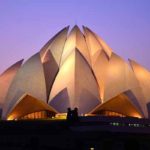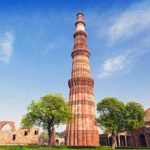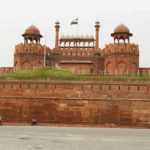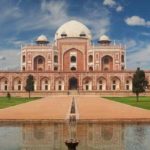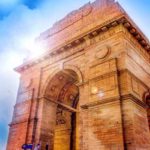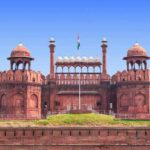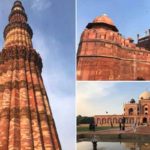15 Top Tourist Attractions Delhi is both an Indian Union Territory and a capital, and it has two very different worlds: New Delhi and Old Delhi. The former, inaugurated as the imperial capital by the British in 1931, is the new capital and seat of government of the country, while Old Delhi is known by many as the symbolic heart of the greater metropolitan region.
Delhi Tourism is one of the world’s most populated areas, a heady mix of tradition and modernity, significant as both a religious hub and the busiest international gateway to India. Its history is as old as the ancient Yamuna River, one of Hinduism’s most holy rivers and a natural dividing line to the west between New Delhi and the east of Old Delhi.
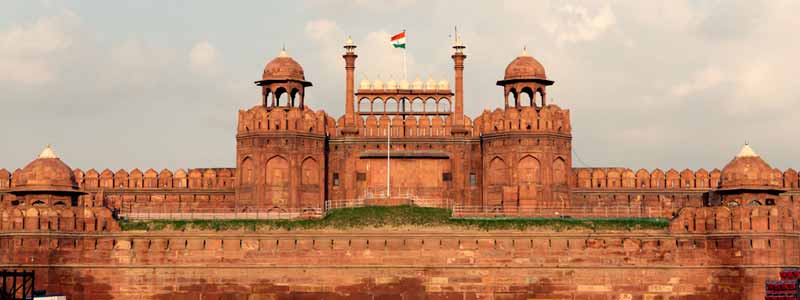
Red Fort – Pride Of Mughal Dynasty
The famous Red Fort of Delhi is known by that name because of its red stone and is one of the most majestic palaces in the world. The history of India is closely connected with this fort, too. It was from here that the last Mughal emperor, Bhadur Shah Zafar, was deposed by the British, marking the end of three centuries of Mughal rule. It was also from its ramparts that India’s first Prime Minister, Pandit Jawharlal Nehru, told the country that India was a colonial free form.
The Mughal emperor, Shah Jahan, decided to move to Delhi after ruling from Agra for eleven years, and laid the foundation stone of the Red Fort in 1618. The main halls of the palace were draped in rich tapestries and decorated with silk from China and velvet from Turkey for its inauguration in 1647. The fort is an irregular octagon with a diameter of approximately one and a half miles and has two entrances, the Lahore and Delhi Gates.
Form the Lahore Gate, a visitor has access to the Chatta Chowk (vaulted arcade) which once housed court jewellers, miniature carpet painters manufacturers, enamel workers, silk weavers, and families of skilled craftsmen as a royal market. The road leads to the Nawabarkhana (band house) from the royal market where the royal band performed five times a day. The band house also marks the entrance into the main palace and all visitors had to dismount here, except royalty.
The Diwan-e-Aam is the public audience hall in the Red Fort. Constructed of sandstone coated with polished shell plaster to look like ivory, the hall is subdivided by columns of 80 x 40 feet. The Mughal emperors were here to hold court and address dignitaries and foreign emissaries. The most imposing feature of the Diwan-e-Aam is the alcove in the rear wall where on a richly carved and inlaid marble platform the emperor sat in state. Examples of Italian pietra-dura work are perfect in the recess behind the platform.
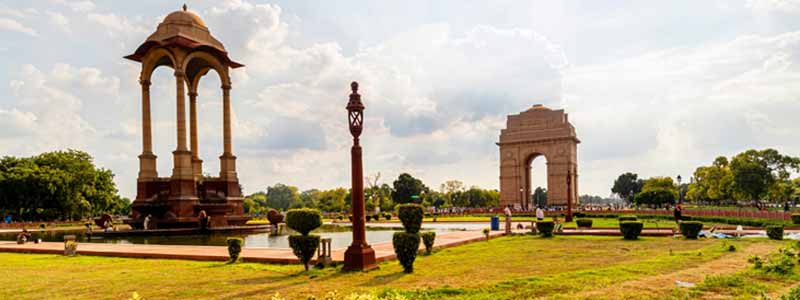
India Gate – India’s Largest War Memorial
One of Delhi’s landmarks is India Gate. This 42-m-high gate, made of sandstone, was the first of its kind in the National Capital. In addition to the 90,000 Indian Army soldiers who were martyred in World War I, the walls of the gateway is inscribed with the names of 13,516 soldiers killed in the Northwestern Frontier in the Afghan War of 1919. The base of the monument is made of red Bharatpur stones and the form of the India Gate is identical to the Arc de Triomphe of France.
India Gate is bordered by lush, well-maintained lawns that serve as a popular family picnic spot. The best time to visit this landmark is at night, when it is bathed in soft golden lights and glows in the dim sky without stars.
The Duke of Connaught laid the foundation stone of this grand monument in 1921 and it was designed by Edwin Lutyens. The monument was dedicated to India a decade later by the then viceroy, Lord Irwin.
Located in front of India Gate, Amar Jawan Jyoti, made of marble, was built in the year 1971. It was constructed to pay tribute to the brave soldiers who, in December 1971, lost their lives during the Indo-Pak War. The flame is guarded by uniformed soldiers and has also been held near it by a sparkling gun topped by an army helmet.
As the President lays a wreath on the Amar Jawan Jyoti, India Gate also hosts the awe-inspiring Republic Day Parade After this, along Rajpath, a grand parade is held and you can see contingents, tanks, colourful floats, weapons all being carried out in a tidy file. School kids and folk dancers enter the parade and give to the whole affair a cultural contact.
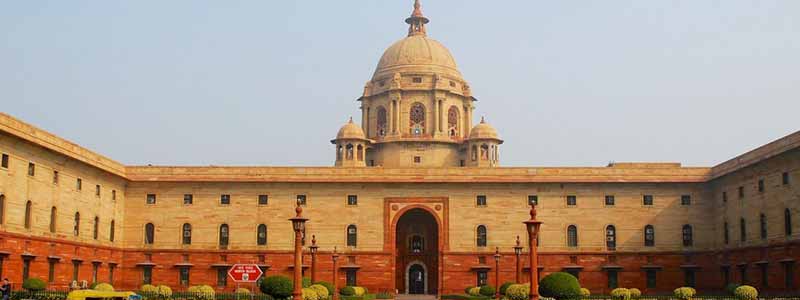
Rashtrapati Bhawan – Presidential Palace
Home to the President of the largest democracy in the world, Rashtrapati Bhavan is emblematic of Indian democracy and its democratic, egalitarian and inclusive values. Sir Edwin Lutyens and Herbert Baker built it and it stands on a 330 acre farm. This presidential palace, completed in 1929, took seventeen years to build. In the house, nearly seven hundred million bricks and three million cubic feet of stone were used This architectural wonder has corridors of 2.5 kilometres and a garden area of 190 acres. An region of 5 acres surrounds the main building and has 340 rooms spread over four floors. The Rashtrapati Bhavan ‘s famous Mughal Gardens cover an area of 15 acres and have 159 celebrated rose varieties, 60 bougainvillaea varieties and many other flower varieties. The Estate also has a state-of-the-art Rashtrapati Bhavan Museum Complex (RBMC) containing, among other items, the Clock Tower, the Stables and the Garages featuring past as well as present presidencies, royal ceremonies, and Rashtrapati Bhavan ‘s rich flora and fauna.
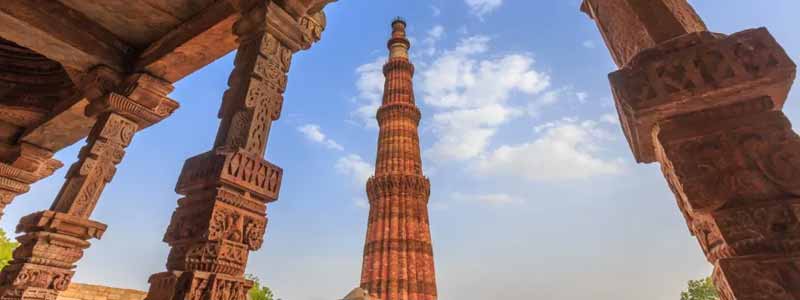
Qutub Minar – Majestic Stone Structure
Qutab Minar, built in 1193 by Qutab-ud-din Aibak immediately after the defeat of the last Hindu kingdom of Delhi, is a soaring, 73 m high tower of victory. The tower has five different floors, each marked by a projected balcony and tapers at the base from a diameter of 15 m to just 2.5 m at the apex. The first three storeys are constructed of red sandstone; marble and sandstone are on the fourth and fifth storeys. The Quwwat-ul-Islam Mosque, the first mosque to be founded in India, is at the foot of the tower. An inscription provocatively informs over its eastern gate that it was built with material obtained from the demolition of ’27 Hindu temples’. In the courtyard of the mosque stands a 7 m-high iron pillar. It is said that your wish will be satisfied if you can encircle it with your hands while standing with your back to it.
Qutab Minar ‘s origins are shrouded in controversy. To represent the beginning of Muslim rule in India, some believe it was erected as a tower of victory. Others claim that calling the faithful to prayer has acted as a minaret to the muezzins.
However, no one can dispute that the tower is not only one of the finest monuments in India, but in the world as well. Qutab-ud-din Aibak, Delhi’s first Muslim emperor, started constructing the Qutab Minar in 1200 AD, but was only able to finish the basement. His successor, Iltutmush, added three more floors, and the fifth and last floor was designed by Firoz Shah Tughlak in 1368.
In the minar, the development of architectural styles from Aibak to Tughlak is very obvious. The relief work and even the building materials used vary. At the foundation, the 238-foot Qutab Minar is 47 feet and tapers at the apex to nine feet. The tower is adorned with bands of inscriptions and four planned balconies with elaborately decorated brackets. While in ruins, one of the world’s most majestic buildings is the Quwwat Ui Islam (Light of Islam) Mosque in the Qutab complex. In 1193, Qutab-ud-din Aibak began construction, and the mosque was completed in 1197.
Jantar Mantar – World’s Largest Sundial
The Jantar Mantar looks like a modern art gallery at first sight. However, it is an observatory. The errors of brass and metal astronomical instruments dissatisfied Sawai Jia Singh II of Jaipur (1699-1743), a keen astronomer and a noble in the Mughal court.
He set himself the task of correcting the current astronomical tables and upgrading the almanack with more accurate resources, under the patronage of the emperor. Jantar Mantar in Delhi is the first of the five observatories he designed with large masonry tools.
The observatory has the Samrat Yantra, a basic sun dial of equal hours, the Ram Yantra, a combination of four scientific devices, for reading altitudinal angles; Jai Prakash, for determining the location of the sun and other celestial bodies, and the Misra Yantra.
Humayun’s Tomb – The Garden Of Tombs
Humayun died after falling from a staircase in 1556 AD. At his palace at Purana Quilla in Delhi, he was laid to rest. Following his death, Hemu, the Hindu general and chief minister of Adil Shah Suri of the Suri Dynasty, assaulted Delhi. The fleeing Mughal army exhumed Humayun ‘s remains and took them to be reburied at Kalanaur in Punjab to protect the sanctity of the remains of their Emperor.
After the death of her husband, Bega Begum, a mourning queen, set out for Mecca to undertake the Hajj pilgrimage and vowed to build in his memory a magnificent mausoleum. She used the services of Mirak Mirza Ghiyas, a Persian architect, hailing from the Herat region of Afghanistan and with an outstanding repertoire. Bega Begum not only commissioned and paid for the tomb ‘s construction, but also oversaw its construction.
As funds dwindled in the royal treasury of the collapsing Mughal Empire, the grandeur of this spectacular building gradually diminished due to lack of maintenance. The surrounding garden was renovated to accommodate an English style garden in 1880, after the establishment of British rule in Delhi. It was, however, restored in a major renovation project between 1903 and 1909 to the original form. When it was used to house refugees during the 1947 Partition of India, the complex and its buildings were heavily defiled. After Humayun ‘s tomb was identified as a UNESCO World Heritage Site by the Archaeological Survey of India (ASI)-Aga Khan Trust for Culture (AKTC), the most recent process of restoration began in 1993.
Akshardham Temple – Experience A Holy Visit
The Temple of Akshardham is a spiritual complex nestled in New Delhi and is a famous Delhi Hindu temple. This wonderful temple was built in 2005 in the New Delhi area of Noida Mor and is known as Swaminarayam Akshardham’s Akshardham Temple. The phrase Akshardham is a combination of two words:’ Akshar’ means ‘eternal’ and ‘Dham‘ means ‘abode.’ In reality, it means the abode of eternal ideals, virtues and ideals that are stated in the Hindu mythology of the Vedas and Puranas. In addition to all this, the Akshardham Temple complex in Delhi exhibits various traditional features, beautiful architecture, Indian culture and spirituality. The main complex in the centre is based on the Vastu Shastra and Pancharatra Shashtra concepts, which are called Akshardham Mandir.
Delhi’s Akshardham Temple is one of Delhi ‘s prime attractions where exclusive architectural beauty can be seen with more than 234 beautifully carved pillars, 9 intricate domes, 20 quadrangle spires, and 20000 Indian spiritual personality sculptures. It is one of the main attractions for history buffs and art enthusiasts, as intricate art and flawless craftsmanship can easily be enjoyed here. In addition , the entire temple is built using Italian Carrara marble and pink sandstone. So, when are you planning on visiting this famous Delhi temple?
ISKCON Temple – Seek Blessings
ISKCON, founded in 1966 by His Divine Grace A.C. Bhaktivedanta Swami Prabhupada, is a spiritual organisation. You can see Bhagavad Gita’s stunning visual presentations with vibrant lights that produce a wonderful effect on the enormous screen. In the evenings, they also plan beautiful robotics and Mahabharata displays. Within the temple premises, there’s a simple Govinda restaurant where you get veg food.
Within the temple, there are lots of museums where you can join the extraordinary exhibits. In addition, they plan interactive displays for the guests. The best time to visit the ISKCON Temple is during the ‘Janmashtami’ festival, Lord Krishna ‘s birthday. It’s celebrated with pomp and vigour, and if you don’t visit this festival at this temple, it’ll be a huge miss.
Lotus Temple – Experience The God
Lotus Temple is a one-h temple located in modern Delhi that facilitates the worship faith of the Bahai. One committed to the unification of all religions and humanity is the Baha’i House of Worship. The other subsidiary buildings abound around the House of Worship that provide relief for the suffering, sustenance for the sick, shelter for the wayfarer, solace for the bereaved and education for the ignorant.
In the Baha’i Religion, there is no clergy and its service consists of prayers and readings of excerpts from the Baha’i scriptures and religious texts of the world’s other religions. The temple reflects the Bahai faith that is broad in its outlook and has a scientific impact that affects people’s hearts and minds. In the Baha’i Religion, there is no clergy and its service consists of prayers and readings of excerpts from the Baha’i scriptures and religious texts of the world’s other religions. The temple reflects the Bahai faith that is broad in its outlook and has a scientific impact that affects people’s hearts and minds.
It means the lord ‘s purity and universality, and the dignity of all religions. The Temple is visited annually by over four million people. This gleaming lotus-like marble structure is situated on the Bahapur Hills (South Delhi) and is the world’s seventh and most recent Bahai worship building. It means the lord and equality of all religions’ purity and universality. The Temple is visited annually by over four million people. Situated on the Bahapur Hills (South Delhi), this gleaming lotus-like marble structure is the seventh and most recent Bahai worship house in the country.
Jama Masjid – India’s Largest Mosques
Delhi’s Jama Masjid (Friday’s Mosque) is the largest mosque in the world, and perhaps its most majestic. It stands at the Red Fort across the road. The Mughal Emperor Shah Jahan’s last architectural extravagance, with a courtyard capable of accommodating 25,000 devotees, is the great mosque of Old Delhi. The mosque measures 65 m by 35 m, and a square of 100 m forms its court. Established in 1656, the Mughal religious fervour is an eloquent reminder There are thousands of faithful who offer their prayers here in its spacious courtyard.
It’s also referred to as ‘Masjid-i-Jahanuma’ or ‘Mosque commanding world view’. It was designed as the principal mosque of Emperor Shahjahan. It is divided from the main road by a sprawling esplanade.
Situated in the ancient town of Old Delhi, five thousand artisans built this monument. On the Bho Jhala, one of the two hills of the old Mughal capital city of Shahjahanabad, stands this magnificent structure. To the east, facing Lal Quila (Red Fort), this monument has three gates, four towers and two minarets. It is constructed of alternating red sandstone and white marble vertical strips. White marble has been used extensively in the three domes and has been inlaid with black stripes.
The structure was built on a high platform so that from all the adjoining areas its impressive exterior would be visible. In the north and south, long flights of steps lead up to the intimidating gateways. The hallmark of this famous mosque are broad staircases and arched gateways. On weekdays, the main eastern gate, possibly used by the emperors, remains closed. The main hall of prayer on the west side is decorated A set of high cusped arches, standing on 260 pillars that support at various elevations about 15 marble domes. On most days, except on Fridays and other holy days, worshippers use this space. The south minaret ‘s premises are 1076-sq-ft wide, where 25,000 devotees will sit together for namaaz (prayer) at a time.
Purana Qila – Old Fort
Purana Quila is one of Delhi ‘s oldest forts, founded at various times under the Mughal emperor Humayun and the Afghan emperor Sher Shah Suri. The impeccable architectural style of the monument and the amazing past attached to it make it one of Delhi’s must-see locations.
The thick ramparts of the fort, which stretch over 1.5 km, rise to a height of 18 metres and have three embowed gateways. The first is the ‘Wide Gate’ of Bara Darwaza facing west, the second is the Humayun Darwaza gate from which one can see the Tomb of Humayun. Except for the third gate, i.e. Talaqi Darwaza, which literally means ‘the forbidden gate’, both the gates are used for the entrance within the fort. With enormous bastions ornamented with vibrant marbles, all the gates are double storied. The fort is a fascinating combination of the architectural style of both Mughal and Indian; which can be seen in the overhanging ‘Jharokhas‘ balconies topped by ‘Chattris‘ pillared pavilions that recall the architecture of rajasthani. All of these, including a few of the interior buildings such as Qila-i-kuhna mosque and Sher mandal, are still restored.
Qila-i-kuhna, designed by Sher Shah Suri, is a single, domed prayer hall that seems to be a copy of the Jami Mosque. There are five-pointed horseshoe-shaped arches on the doorway of the monument that illustrate the influence of pre-Mughal architectural architecture. In comparison, Sher Mandal is a double-storey octagonal tower built of red sandstone, topped by an octagonal pavilion. As per the papers, it is one of Delhi’s first observatories. And the remains of the stone shelves decorated with ornamental plasterwork show it once was an Emperor’s library.
Bangla Sahib Gurudwara – Offer Prayers
For their hospitality, Gurudwaras have always been remembered. Without having langar, which they serve on a daily basis, no one leaves a gurudwara. All sheds their ego outside the door of the holy house, from rich to poor, and helps with cooking, serving, cleaning, and other duties. And the kitchen of Bangla Sahib Gurudwara, one of the largest in Delhi, is still working during a pandemic, serving meals to the hungry scattered in the area It is currently catering to the underprivileged who have lost their homes, and some, their livelihoods since the lockdown, regardless of religion, religion, and context.
The kitchen ramped up to produce 80,000 meals, and then one lakh, beginning with 40,000 meals a day. Soon, the gurudwara authorities said they could serve nearly three lakhs of rice. According to them, during severe times, such as wars and plagues, the Bangla Sahib Gurudwara remained a safe haven in the National Capital and unconditionally serves simple vegetarian food.
National Rail Museum – Buy A Souvenir
The National Rail Museum is mainly focused on preserving the country’s rail heritage. Perhaps the oldest mono-rail idea, launched in 1907, is the Patiala State Mono Rail Tram Way (PSMT), and NRM has the only working steam mono-rail locomotive and coach. One of the other displays and figures in the Guinness Book of World Records is the oldest operating “Fairy Queen” steam locomotive. The last “John Morris Fire Truck” solid rubber tyre operating vehicle, which is over 100 years old, is on view. The preserved exhibits include antique exhibits such as the Prince of Wales saloon, the Mysore Maharaja saloon, a fireless steam locomotive, rail buses, rail cars, electric locos, etc. The museum offers events and services for all ages, such as summer camps, on a daily basis. A miniature Indian rail model, and toy train rides are some of the other highlights at the museum.
Lodhi Gardens – Heritage Amidst Nature
Lodhi Garden is situated next to the International Center of India, which is only 3 kilometres from the Tomb of Humayun. It is one of the Delhi Historical Gardens. The garden of Lodhi houses the tombs of the rulers of Sayyid and Lodhi.
Lodhi Garden was set up by the Sayyid and Lodhi rulers between the 15th and 16th centuries. The garden is very well preserved and also has several historical monuments that are an additional tourist attraction.
In 1968, JA Stein and Garrett Eckbo re-designed the Lodhi garden in Delhi and that’s how it got its present form. You have to visit the tombs of Muhammad Shah, the third chief of the Sayyid dynasty, and Sikandar Lodhi in Lodhi Garden.
In the centre of Lodhi Garden in Delhi, there is a Bara Gumbad and Sheesh Gumbad that talk about the architectural glory of that period. The former consists of a wide rubber dome, a three-dome mosque, and a residence surrounding a central courtyard containing the remains of a water tank, and the Sheesh Gumbad, consisting of the remains of an unknown family, lies opposite this Bara Gumbad.
Tomb Of Safdarjung – Experience History
The last garden tomb built in the late Mughal Empire style is the Safdarjung Tomb. It is the sandstone and marble mausoleum of Mirza Muqim Abul Mansur Khan, a Mughal statesman popularly known as Safdarjung. This monumental tomb appears to be architecturally influenced by the tomb of Humayun, though slabs from the tomb of Abdul Rahim Khankhana were used for its construction.
The Safdarjung Tomb has a double-storey entrance gate and a five-part façade, all beautifully built in purple. It also has an Arabic inscription that says “When the hero of plain courage departs from the transient, may he become a resident of the paradise of Heaven.” There is a nine-fold floor plan for the tomb that includes several rooms and libraries. The three domed mosques sit on the right side of the main gate. The façade and the central dome constructed on the terrace give the Safdarjung mausoleum a resemblance to that of the Taj Mahal, except for the lack of symmetry due to the structure’s vertical prominence. Also, the four octagonal towers on its four corners vary from the Taj Mahal, where they remain disconnected from the tomb’s façade.
The Mughal empire was in its stage of decline when the Safdarjung tomb was constructed. Therefore, low building material quality is used, such as sandstone instead of marble. This is why, for lack of consistency and also for lack of proportionality, the architecture of the monument has been criticised. But its unsurpassed glory still gives tourists a justification to need to see this place on their Delhi sightseeing tour.

